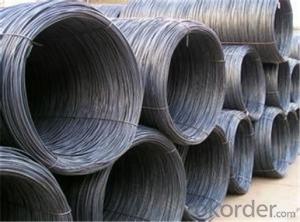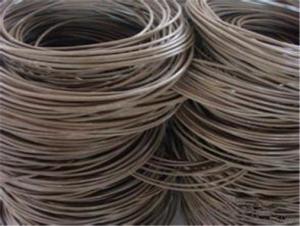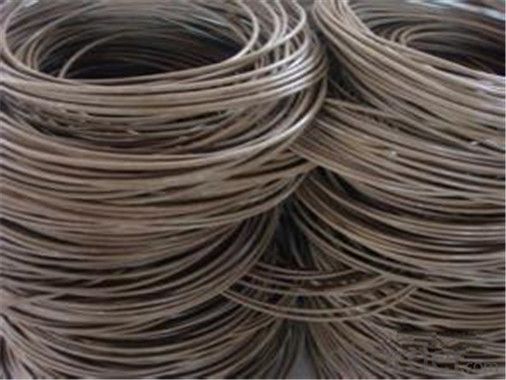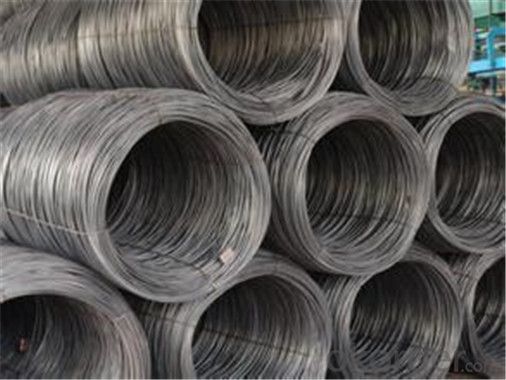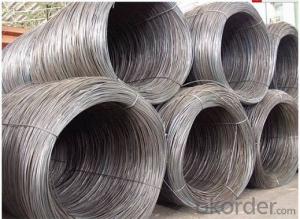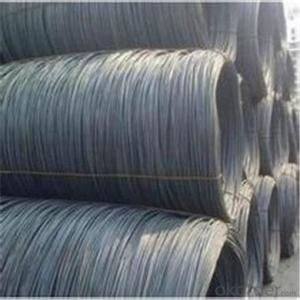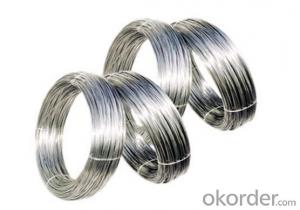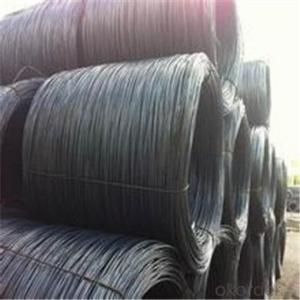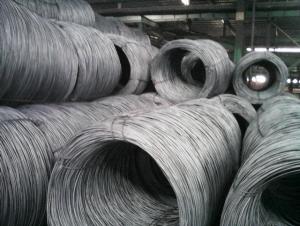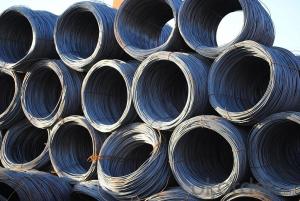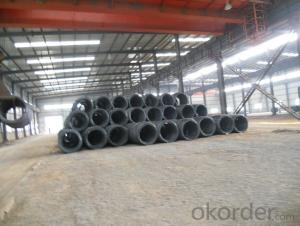SAE1006B Steel Wire Rod 5.5mm with Best Quality in China
- Loading Port:
- Tianjin
- Payment Terms:
- TT OR LC
- Min Order Qty:
- 200 m.t.
- Supply Capability:
- 45555555 m.t./month
OKorder Service Pledge
OKorder Financial Service
You Might Also Like
Specification
Description of wire Rod:
1. Drawn wire specialist, your wire rod solution
2. ISO9001 Certified Mill &SGS
3. Feature: machinability, high hardness, toughness, corrosion resistant
4. Clear and smooth surface, high precision and Tolerance control: ± 0.01
5. Customized service for your special requirement
6. Reasonable and more competitive mill price for you.
Festures of wire Rod:
1. Drawn wire specialist, your wire rod solution
2. ISO9001 Certified Mill &SGS
3. Feature: machinability, high hardness, toughness, corrosion resistant
4. Clear and smooth surface, high precision and Tolerance control: ± 0.01
5. Customized service for your special requirement
6. Reasonable and more competitive mill price for you.
Specifications of wire Rod:
Product | steel wire rod |
Standard | AISI, ASTM, BS, DIN, GB, JIS |
Material/steel grade | Q195-Q235,SAE1006, SAE1008, SAE1010, SAE1018, SAE1020 or according to customers requirements |
Wire Gauge | 5.5-12mm |
Coil weight | 1.8-2.1mts |
MOQ | 25MT |
Delivery Time | 15-30 days after receipt of L/C or deposit by T/T |
Packing | In coil and load in container, if large quantity, by bulk vessel; Can be packed as customers' special requirements |
Payment terms | 1).100% irrevocable L/C at sight. |
Application | widely used in machinery parts, manufacturing industry, electronics industry, metal tools and others |
Images of wire Rod:
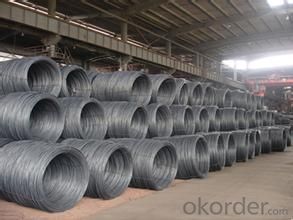
FAQ:
1. What is your package?
Packing situation: standard seaworthy packing or as customer required.
2. How long is the lead time?
Delivery time: 45 days after order confirmed.
3. What payment term do you accept?
Payment: T/T or L/C at sight.
- Q: What are the standard bending requirements for steel wire rod?
- The bending requirements for steel wire rod vary depending on the industry or application in which it is used. However, there are commonly followed general guidelines and specifications. The diameter or gauge of the steel wire rod is a key factor in determining the bending requirements. Thicker wire rods require a larger bending radius to prevent excessive strain or deformation during bending. The type of steel used in the wire rod also affects the bending requirements. Different steels have varying levels of ductility and tensile strength, which impact the bending process. Adhering to the manufacturer's specifications and guidelines is crucial to avoid excessive stress or damage during bending. Industry standards and regulations may also dictate specific bending requirements for steel wire rods. For example, ASTM A510, established by the American Society for Testing and Materials (ASTM), provides guidelines for carbon steel wire rods in various applications. Ultimately, the bending requirements for steel wire rod depend on factors such as diameter, steel type, and industry standards. Consulting relevant specifications and guidelines is essential to ensure proper bending procedures, maintaining the wire rod's integrity and functionality.
- Q: What are the common production processes for meitnerium-coated steel wire rod?
- The common production processes for meitnerium-coated steel wire rod include cleaning the steel wire rod, applying a layer of meitnerium coating through physical vapor deposition or electroplating methods, and then subjecting the coated wire rod to curing or annealing processes to ensure proper adhesion and durability of the coating.
- Q: What are the common applications of alloy steel wire rod?
- Common applications of alloy steel wire rod include the manufacturing of automotive parts, construction materials, machinery components, and electrical equipment. It is also used in the production of springs, cables, wire mesh, and various types of fasteners.
- Q: What are the common applications of deformed steel wire rod?
- Deformed steel wire rods are commonly used in a variety of applications such as construction, reinforcement of concrete structures, manufacturing of nails, wire mesh, fencing, and various other industrial purposes.
- Q: How is the steel wire rod market segmented?
- The steel wire rod market can be divided into different segments based on various factors including product type, application, and geography. Product type segmentation includes low carbon steel wire rod, medium carbon steel wire rod, and high carbon steel wire rod. Each type of wire rod has distinct properties and is used for specific applications. For instance, low carbon steel wire rod is commonly utilized in construction, automotive, and general manufacturing industries. On the other hand, medium carbon steel wire rod is primarily used in the construction industry for reinforcing purposes. High carbon steel wire rod is mainly employed in the production of wire for springs and ropes. Application segmentation encompasses construction, automotive, energy, agriculture, and other industries. The construction industry is a significant consumer of steel wire rod as it is extensively used for reinforcing concrete structures. In the automotive sector, steel wire rod is employed in the manufacturing of components such as springs, cables, and tire reinforcements. The energy industry also utilizes steel wire rod for power transmission lines. Additionally, steel wire rod finds applications in the agriculture sector for fencing and other purposes. Geographically, the steel wire rod market can be segmented into North America, Europe, Asia Pacific, Latin America, and Middle East & Africa. Each region demonstrates its own demand for steel wire rod driven by factors such as economic growth, infrastructure development, and industrialization. Asia Pacific stands as the largest market for steel wire rod due to the rapid growth in construction and automotive industries, particularly in countries like China and India. North America and Europe also exhibit significant demand for steel wire rod owing to their well-established construction and automotive sectors. In conclusion, the segmentation of the steel wire rod market provides a comprehensive understanding of market dynamics, enabling companies to target specific segments and customize their products and marketing strategies accordingly.
- Q: What are the different testing methods for steel wire rod?
- Steel wire rods can be evaluated for quality and characteristics using various testing methods. Common methods include: 1. Tensile Testing: The steel wire rod is subjected to tension until it breaks, allowing for the measurement of its maximum load-bearing capacity and providing information on tensile strength, yield strength, and elongation. 2. Bend Testing: The steel wire rod is bent to a specific angle and examined for cracks or fractures, assessing its ductility and resistance to deformation. 3. Hardness Testing: The hardness of the steel wire rod is measured using techniques like Rockwell, Brinell, or Vickers hardness tests. This determines the rod's ability to resist indentation or penetration. 4. Microscopic Examination: The microstructure of the steel wire rod is examined under a microscope to assess grain size, inclusion content, and overall quality. 5. Chemical Analysis: The chemical composition of the steel wire rod is analyzed to ensure it meets required specifications and standards. 6. Ultrasonic Testing: High-frequency sound waves are used in this non-destructive testing method to detect internal flaws or defects in the steel wire rod, assessing its integrity and identifying potential weaknesses. 7. Dimensional Inspection: Physical dimensions of the steel wire rod are measured to ensure they meet specified tolerances and requirements. By employing these testing methods, manufacturers and quality control personnel can ensure that steel wire rods meet necessary standards for their intended applications.
- Q: How is steel wire rod used in the manufacturing of wire for seismic reinforcement in buildings?
- Steel wire rod is an essential component in the manufacturing of wire for seismic reinforcement in buildings. This type of wire is commonly known as seismic wire or seismic reinforcement wire. Seismic reinforcement is crucial in construction to enhance the structural integrity of buildings, especially in earthquake-prone areas. It helps to minimize the damage caused by seismic activities and ensures the safety of occupants. Steel wire rod serves as the raw material for producing seismic wire due to its desirable properties. Steel wire rod is manufactured through a process where billets, which are semi-finished steel products, are heated and then passed through a series of rollers to obtain the desired diameter. Once steel wire rod is obtained, it undergoes further processing to transform it into seismic wire. This process involves a series of steps such as drawing, annealing, and galvanizing. Drawing involves pulling the wire through a series of dies to reduce its diameter and increase its strength. Annealing is a heat treatment process that helps improve the wire's ductility and flexibility, making it more suitable for seismic reinforcement applications. Galvanizing is the process of applying a protective zinc coating to the wire to prevent corrosion. The resulting seismic wire, made from steel wire rod, is then used in various ways to reinforce buildings. It is commonly used in reinforced concrete structures, where it is embedded within the concrete to increase its tensile strength. The wire is typically formed into grids or meshes that are placed strategically within the concrete to provide additional strength and prevent cracks or failure during seismic events. Moreover, seismic wire can also be used in the form of steel ropes or cables, which are tensioned and anchored to different parts of a building. These cables help distribute the seismic forces horizontally and vertically, reducing the overall stress on the structure and improving its resistance to earthquakes. In summary, steel wire rod plays a vital role in the manufacturing of wire for seismic reinforcement in buildings. Through a series of processes, steel wire rod is transformed into seismic wire, which is used in reinforced concrete structures and as tensioned cables to enhance the structural integrity of buildings and mitigate damage caused by seismic activities.
- Q: What are the different wire drawing lubricants used for steel wire rod?
- There are several different wire drawing lubricants used for steel wire rod, including soap-based lubricants, oil-based lubricants, and synthetic lubricants. Soap-based lubricants are commonly used for mild steel wire rod, as they provide good lubrication and cooling properties. Oil-based lubricants are often used for high carbon and alloy steel wire rod, as they offer better lubrication and reduce friction during the drawing process. Synthetic lubricants, such as water-based polymer lubricants, are also used to improve surface finish and reduce wear on the wire rod during drawing.
- Q: How does the cost of steel wire rod compare to other materials?
- Compared to other commonly used materials for similar applications, steel wire rod often has a lower cost. Its wide availability and large-scale production contribute to its relatively affordable price. Furthermore, steel's high recyclability adds to its cost-effectiveness. When compared to alternatives like aluminum or copper wire rod, steel wire rod is generally more economical. However, it is crucial to take into account factors such as market demand, quality, and specific application needs as these can affect the cost of steel wire rod.
- Q: What are the common production processes for tin-coated steel wire rod?
- The common production processes for tin-coated steel wire rod include wire drawing, annealing, tin coating, and further processing such as cutting and coiling.
Send your message to us
SAE1006B Steel Wire Rod 5.5mm with Best Quality in China
- Loading Port:
- Tianjin
- Payment Terms:
- TT OR LC
- Min Order Qty:
- 200 m.t.
- Supply Capability:
- 45555555 m.t./month
OKorder Service Pledge
OKorder Financial Service
Similar products
Hot products
Hot Searches
Related keywords
